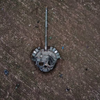offline
- Koridor
- Legendarni građanin
- Pridružio: 02 Feb 2015
- Poruke: 3141
|
Irbis ::Koridor ::
Irbis ::
Pa prema dosadasnjim podacima iz Sirije President S ne vredi nicemu jer po slikama i MI35M ga imaju i poljubio je zemlju,Mi8 ga je imao i trusnuo je znaci onda nesto nevalja. Oba puta od SSSR PVO sistema,a nesto ne vidim ni helikoptere vise u blizini prve linije fronta.
Ipak moras nauciti kako rade neki sistemi i protiv-sistemi (dobro ti je bojank rekao). Samo cu ti reci da je Igla vrlo VRLO zajeban laki prenosivi PVO sistem (MANPAD po novosrpskom). Ako padaju helikopteri tek Igla moze da napravi pomor medju BPL....VRS je obarala i predatore za vrijeme rata u BiH a kamo li ove iranske sklopocije...
Vrlo rado bih naucio kada bi imao odakle(ako imas neki izvor posalji mi u PP,ili otvorite posebnu temi i objasnite lepo i za protiv-sisteme na vazduhoplovima i oklopnim vozilima) svi Ruski izvori ga velicaju i dizu u nebesa,a onda dodju u Siriji i padaju kao kruske,pa prestanu da lete na prvoj liniji fronta. Naravno da se moze BPL oboriti,ali zrtava nema,a ovako je 2,pa 5 to je vec 7 ljudi. Evo ni Mi28 ni Ka52 ne lete sem nad samom bazom. Iracki su se dobro pokazali,ali Rusi iz nekog razloga od pada onog Mi28 vise ne koriste.
Nema sta da ti saljem. 1999 Pentagon nije dao da se koriste Apaci nad Kosovom zbog prevelikog rizika od obaranja. Evo ti iz Clarkove knjige tj intervjua:
"Clark's skirmishes with the Pentagon continued. He spent weeks trying to win permission to use low-flying Apache helicopters, but Army officials, he said, were so concerned about losing them that they blocked combat deployment."
Clark je trazio da mu dozvole upotrebu, Pentagon nije dao. Isto i u Siriji, veliki rizik (bez obzira na prezident-s) i prizemljuj.
Evo i clanak iz NYT da vidis sta je "strah od Igle" hehe
GUNSHIPS
The Apaches Will Face High Risk Over Kosovo
Related Articles
G.I. Prisoners: 3 Captive Soldiers Tell of Isolation in Yugoslav Cells
Issue in Depth: Conflict in Kosovo
Forum
Join a Discussion on The Conflict in Kosovo
By STEVEN LEE MYERS
WASHINGTON -- One night, maybe soon, the first U.S. Apache helicopters are supposed to take off from a makeshift base in Albania, pause to refuel in the rugged northern Albanian hills and then, with rockets raining ahead of them, fly into Kosovo to try to do what NATO's high-flying jets have not done: eviscerate Yugoslavia's armored forces.
Such attacks carry enormous risk, though. And for that reason President Clinton still has not approved their use in combat in the Balkans.
Even as the Pentagon touted "the most capable and lethal helicopter in the world," and parked one on its lawn today for display, officials said they feared that the Apaches in the Balkans could be shot down with relative ease and so have withheld the final authorization.
While NATO's raids have weakened Yugoslavia's air defenses, the Apaches would still be particularly vulnerable to shoulder-fired missiles and even small-arms fire, the officials said. Those missiles, including SA-7s, have been largely unaffected by NATO's strikes, and Yugoslavia's armed forces are said to have hundreds of them.
"We don't have any confidence we have taken any of those out," a senior defense official said, speaking on condition of anonymity. "You don't know where some guy is going to come out of the woods with an SA-7. They could really have those anywhere."
And when they fire, the official added grimly, "there's no warning."
It has been six weeks since NATO's senior commander, Gen. Wesley Clark, requested them and nearly a week since he went to their base at Albania's main airfield and declared that they would enter the fray soon. But officials in Washington said it could be many more days or even weeks before they are ready to risk their use over Kosovo.
"This is higher risk than dropping bombs at 40,000 feet," a senior military official said.
The use of the Apaches would open a new phase in a war that so far has been fought from great heights, at great distances. Apache pilots, flying no more than 100 feet off the ground, will for the first time confront Yugoslav troops up close -- in what one officer described Friday as warfare's equivalent of "a knife fight."
The concern over their use has underscored the Clinton administration's insistence on minimizing the risk to U.S. and NATO pilots, avoiding casualties at all cost. It also highlighted a rift with NATO's commanders, including Clark, who have pressed political leaders to do more against Yugoslav army and paramilitary units in Kosovo.
In a meeting with reporters this week, Gen. Klaus Naumann, the German who is chairman of NATO's military committee, referred to the divisions over using the Apaches as "a battle." He added, "What I know for sure is that the Apache is a marvelous instrument to cope with the situation we are confronted with right now in Yugoslavia."
The Apache helicopter -- officially the AH-6HA -- was designed during the Cold War to counter thrusts by Soviet tanks, other armored vehicles and artillery batteries. Narrow and boxy and bristling with weapons, it hugs the terrain, flying at speeds up to 200 miles per hour just above treetops and telephone wires, even in the dead of night.
Each Apache carries 16 Hellfire missiles, which can be fired within eight minutes with a range of nearly five miles, as well as 38 smaller rockets and a 30-mm cannon. Its two pilots have eyepieces attached to their helmets, letting them scan targets through a grainy black-and-white image and guide missiles with lasers.
The Apaches were acclaimed for their success during the Persian Gulf war in 1991, when they destroyed scores of Iraqi tanks and vehicles. Only one was shot down. But Yugoslavia is not Iraq, and the terrain, weather and potency of the Yugoslav defenses poses a significantly tougher challenge.
At the Pentagon on Friday, Col. Michael Hackerson, a former Apache pilot who is now the Army's deputy chief of staff for operations, said the Apaches would make "deep strikes" from Albania with the support of long-range rockets that pounded enemy air-defense targets. The Apaches, he said, could use their lasers to identify targets for the higher-flying warplanes.
Hackerson said it was unlikely that the Apaches, which usually fly in pairs, would go into Kosovo and search for targets. Instead, he said, they would fly to targets already spotted by spy satellites or reconnaissance aircraft.
That could limit the effectiveness of the Apaches, since the Yugoslav forces, unlike the amassed Soviet columns they were designed to take out, are dispersed and hidden, in some cases in churches or barns.
"It'll be a little more disorganized than a normal column of tanks that you would see and be able to identify, but that's a risk that, you know, we're prepared to take," Hackerson said. Referring to Yugoslavia's shoulder-fired missiles, he added, "It could potentially turn into a bit of a knife fight."
From the start, the Apaches' deployment has been a bit rocky. NATO authorized their use on April 5, but their arrival in Albania was delayed by a sluggish bureaucracy, the austerity of Albania's airport and finally foul weather. One helicopter broke down in Italy. On Monday, one crashed while training in Albania.
Meanwhile, the number of soldiers and weapons backing them up continues to grow. Last week, the Pentagon announced that it was bolstering the force with 15 tanks, 14 more Bradley armored vehicles, 8 howitzers and other heavy weapons. Those forces, which officials said were needed to protect the Apaches, are not supposed to start arriving until next week.
|


















